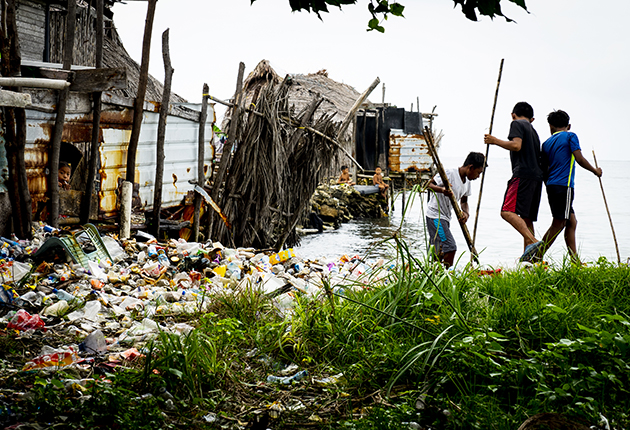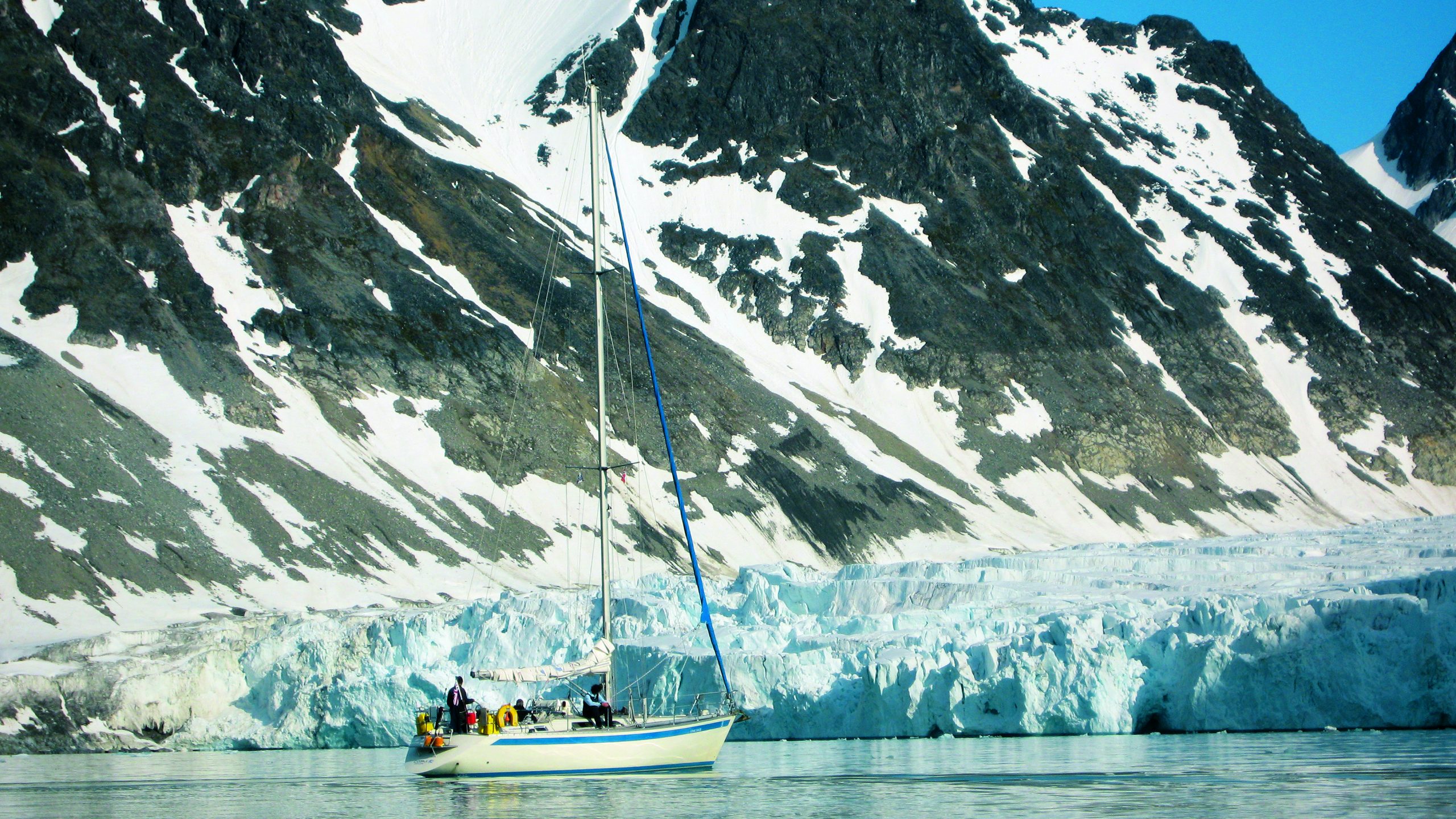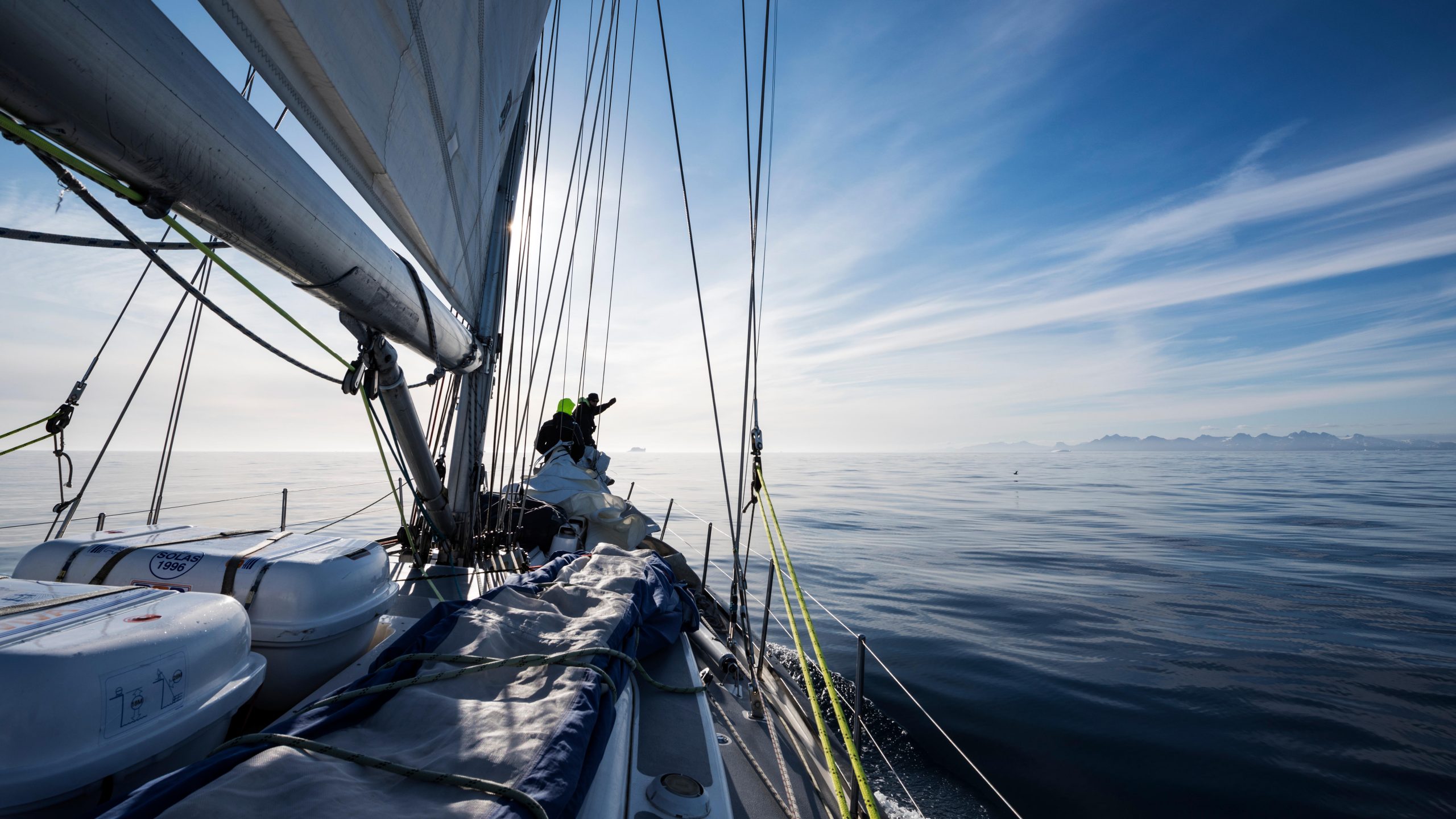Jon Amtrup looks at how climate change is affecting the Svalbard archipelago. His article has won the 2022 Brian Black Memorial Award
The sound kind of creeps up on you. Pretty much like climate change.
You think it’s all quiet walking along stranded icebergs on Svalbard.
But then you hear it in the Arctic silence: the discreet crackling of old air, millions of years old, that is freed from the melting ice and released into a new world. But more of the melting ice later.
Every story has a beginning, and our story starts in Tromsø, Norway.

The waters around Bear Island are rich in sea life, but an oil spill could threaten this. Credit: James Austrums
We were just a tiny white speck in all the blue. Behind us, mainland Norway slowly sank into the sea. Ahead of us lay adventure and the Barents Sea.
We were heading for Svalbard on Isbjørn, a Swan 48 from 1972, and the usual three layers of wool were down below.
We were sweating away in t-shirts and shorts. I know that weather is not the same as climate, but when you have to put on shorts and massive amounts of sunscreen above 69° north in May, the chances are that something’s wrong.
The climate is changing fast, and even faster in the Arctic.
The sea monster
Some 110 miles south of Bear Island a monster appears on the horizon. In the middle of flocks of kittiwakes, fulmars, whales, and other life-giving creatures a giant structure and ships stand out.
It is an oil platform named after a politician that stood on the side of the not-so-fortunate.
Johan Castberg (1862-1926) was a very influential Norwegian politician for the Labour Party. He was very progressive and implemented laws that granted legal rights to children born outside wedlock. Now, his name is greenwashing oil production that is destroying the future of coming generations.

The fulmars, like other ocean flying birds, depend on access to fish to live and prosper. Their lives are threatened by climate change. Credit: James Austrums
This oilfield is the most northerly in Norway, so far. This is because oil companies, and many politicians, look at the melting of the Arctic as a good way to drill for new oil even further north.
Oscar Wisting was another famed Norwegian. Together with Roald Amundsen, he was the first to reach both poles. Now his name is glued to an oilfield even further north than Castberg.
Scientific organisations such as the Norwegian Polar Institute and the Institute of Marine Research have advised against oil exploration so close to the ice edge.
If an accident should happen in the winter, the chances of cleaning up oil spills are tiny. The weather is too harsh with ice and extreme cold, and there is no infrastructure to support a clean-up as the oil installation is 150 miles from the mainland.
The ice edge is not something that can or should be controlled by political decisions, even though some leading Norwegian politicians seem to think so in order to feed their hunger for oil.

Leaving Tromsø in May was a hot experience for the crew of Isbjørn. Credit: James Austrums
We can only watch the oil platform sink on the horizon as we continue our journey to the higher latitudes.
On Bear Island, we anchored for the night in Grytvika, a cove on the north of the little island. The southerlies came rushing down over the steep cliffs packed with nesting fulmars.
But the holding was good, and the small beaches below the kittiwakes’ cliffs were soon rid of all plastic debris.
You can’t sail to the Arctic, or anywhere, without making an effort to leave it more pristine than you found it.
Plastic is one of the many dangers that are taking its toll on the ocean and the life in it.
The sunny night came and went, and as we sailed over to the met station we threw a fishing line in the sea. Five minutes later we had four big cod on deck, providing us with a heavenly fresh dinner.

Isbjørn’s crew cleaned the beach of plastic debris while visiting Bear Island. Credit: James Austrums
According to the employees on the met station on Bear Island they don’t ‘fish’ as such – they go out to ‘collect’ fish when they need to.
In the spring and summer, the waters and hills are teeming with life because of the phytoplankton.
These microorganisms are the foundation for all other life in the sea and the birds, and the algae blooming takes place in the spring, following the ice edge where cold and warm water meet. As the ice edge melts northwards as the months get warmer, new areas become available for algal blooming.
Zooplankton feeds on algae, and zooplankton provides food for fish, sea birds, and marine mammals.
Climate change: Dark thoughts
If an oil spill should happen in these areas the consequences could be devastating for all life in and on the ocean, according to experts and environmentalists alike.
The rich fishing ground could be left dead for years, and the whales and birds that feed on the same fish will also be affected. The fact that the ice edge moves north affects all animal life in the Arctic.
The journey to the ice edge for feeding can become too long for polar bears and sea birds. Researchers are already seeing birds such as ivory gulls, kittiwakes, and little auks opting to graze in front of glaciers in Svalbard.

Tourists come to Svalbard to see polar bears up, close and personal. Credit: James Austrums
Polar bears that remain on Svalbard risk starvation.
Sitting at the helm of Isbjørn, after we left Bear Island, I can’t stop thinking of man’s greed. We have the resources and knowledge to extract more oil from this natural pristine ground. And we are doing it to fuel an ever-increasing consumption of luxury.
We also have knowledge about the consequences of burning fossil fuels on our climate. We have had that knowledge since the 1980s, but still we continue as if we have another planet, ocean, and afterlife that will provide the solution to climate change.
Continues below…
Polluted Paradise: Brian Black Memorial Award winner for 2021
Sophie Dingwall sees firsthand the impact of plastic pollution on the Caribbean's population. Her article - Polluted Paradise - has…
B&G renew sponsorship of the Brian Black Memorial Award for 2022
World-leading sailing navigation and instrument specialist B&G will be continuing to support the Yachting Monthly Brian Black Memorial Award in…
Brian Black Memorial Award 2022: £4,000 prize on offer for environmental journalism
Back for a second year, the Brian Black Memorial Award 2022 is inviting entries to celebrate the best writing about…
Sailing in the Arctic: how to cruise to the far north
Once you’ve experienced the beauty and peace of sailing in the Arctic, you’ll want to return again and again. Andrew…
One of the best things about sailing in the high latitudes is how little you need. A pair of trousers, good hiking shoes, a shirt or two, wool sweaters and underwear, and good weather gear that works both on land and offshore. That’s all.
When it comes to food we always plan well because it is a scarce resource, so we don’t let anything go to waste. The same with water and fuel. Save as much as possible to make everything last as long as possible.

The Svalbard reindeer has become a dish on the polar bears’ menu as it struggles to find food. Credit: James Austrums
Exploring nature on its own terms is the main focus, and our life becomes sustainable out of necessity. We don’t have room for all the luxury we have back home, but we soon realise we don’t need it anyway.
It is a happy existence as we don’t have the hassle of having to pop out every day to buy supplies – there aren’t any shops here.
The climate change we see
When I first sailed to Svalbard in 2010, Hansbukta did not have a beach you could walk on. The glacier Hansbreen was stretching out into Hornsund south
of Spitsbergen and was constantly releasing small and big bits of ice into our anchorage.
At times we had to fight the big pieces of floating ice with a pole to prevent them from trapping our anchor chain.
Twelve years later and most of Hansebreen has retreated into dry land.

Once ice, now muddy beach, the retreat of glaciers clearly point to how much climate change is impacting the Arctic. Credit: James Austrums
According to a study conducted by researchers on the Polish station in Hornsund, Hansbreen retracted 400m between 2000 and 2005. That’s nearly 100m per year, and the retreat has continued at the same scary pace.
Now, I am walking in soft black silt on a beach on my way to the front of the glacier. This muddy beach hasn’t been exposed to the midnight sun for thousands of years.
Like most other glaciers on Svalbard, and in the rest of the world, it has shrunk due to rising temperatures. Our boots get muddier as we walk toward the front of the glacier.
The ground is soft with black, sticky silt. And the black silt I’m now walking on enhances the melting even more as the sunlight, that a few years ago got reflected back into the atmosphere by the white surface of the glacier, now gets soaked up by the earth and ocean that is now exposed.

Isbjørn anchored off the met station on Bear Island, where the impact of climate change can be seen. Credit: James Austrums
The heating of the darker surfaces and the ocean leads to even more melting of ice. The spiral keeps spinning faster and faster as the ice melts.
Further into Hornsund lies the Hamberg and Hornberg glaciers. Together they stretch over to the east coast of Spitsbergen.
In the last 100 years, this ice has retreated 17 kilometres, according to studies done by the researchers on the station under the pointy peaks of Hornsund.
Their estimates say that in 30-40 years the glaciers will be gone and Spitsbergen will be turned into two islands. Maybe we can even sail through the new sound when the glaciers have turned to water?
It sounds intriguing, but it is actually really depressing. We are slowly changing the Arctic by destroying it.
The last cruise
Arriving in Longyearbyen, we are once again connected to the world through our mobile phones.
For a week we have been in our own happy world just sailing along watching whales breach, walruses looking curiously at us, and have kittiwakes defecate on us, like some form of environmental payback for not caring enough about nature.
But the news is very seldom positive.
The first news article that catches my attention is entitled: Exceptional Warming Over the Barents Area
New research shows that parts of the Arctic are heating up very fast. The northern Barents Sea has been warming five to seven times more than the
rest of the world.

Longyearbyen is popular with cruise ships during the high season. Credit: James Austrums
The heating in the Barents Sea region is an early indication of what could happen across the rest of the Arctic.
The problem is that the Arctic is so far away from most people. Why should it be of any importance to a family living in China, for instance?
According to scientists, the heating is suspected to trigger increases in extreme weather in North America, Europe and across Asia. So that’s yet another scientific research report that tells us about the dire consequences of our lifestyle choices.
Meanwhile, in the four-mile long Adventfjorden bay, seven big cruise ships lie at anchor just outside Longyearbyen.
A host of smaller shuttle ships are going back and forth between the huge mother ships and the mainland, and charter planes are bringing new guests to the area, flying through the black smoke being expelled from the cruise ships before landing at Longyearbyen airport.

Plastic litter washes up on the beaches on Svalbard too, threatening life on land and in the sea. Credit: James Austrums
They are power-hungry creatures with generators and engines working 24/7 to keep the food coming, drinks cold, linens clean and temperatures comfortable for the hundreds of guests on board.
It is beyond a paradox that many cruise companies use marketing taglines such as ‘Come to the fragile Arctic before it melts’ when the carbon footprint they are responsible for is an entirely unsustainable way of travelling.
So we sat in the cockpit on Isbjørn, watching this hectic scene unfold.
We are longing for a mild breeze that can ghost us quietly north along the coast of Spitsbergen; to an anchorage where we are solitary, just enjoying the high latitude scenery.
Maybe a polar bear comes walking alone. Maybe not…
Brian Black Memorial Award 2022 sponsored by B&G

Brian Black was as passionate about the marine environment as he was eloquent in his writing and filmmaking about the crises facing Arctic ecosystems, including climate change.
A television journalist for RTE in Ireland, UTV in Northern Ireland, and later through his own production company, he was also a lifelong sailor and regular contributor to Yachting Monthly.
His wife Lesley was a sailor and author in her own right, becoming Northern Ireland’s first female yacht club commodore, blazing a trail for women in sailing.
As a memorial to Brian and Lesley Black, the Black family, in conjunction with Yachting Monthly, established an award to celebrate sailing adventures which shed fresh light on marine environmental issues.

Brian Black spent years raising awareness of climate change and its impact on high latitudes. Credit: Black family
The award aims to find the very best writing that gives voice to the marine environment and brings a new perspective to readers.
The judges include round- the-world race winner, multiple world champion Mike Golding OBE; six-time circumnavigator and Volvo Ocean Race skipper, Dee Caffari MBE; conservation expert, Dr Robert Brown OBE; marine environmental consultant and daughter of Brian and Lesley Black, Sarah Brown; and the Yachting Monthly editorial team.
The award is sponsored by B&G and supported by The Green Blue, the RYA, Imray, the Royal Highland Yacht Club, the Irish Cruising Club, and the Ocean Cruising Club.
The winning entry receives a cash prize of £2,500 and a donation of £1,500 to the marine conservation charity Sea-Changers; publication of their work in YM; a presentation hosted by YM and the judging panel; a physical award, and the right to use the award logo. Visit www.yachtingmonthly.com/brianblack for full details about the competition. You can also read the winning entries from 2021.

Yachting Monthly’s Brian Black Memorial Award, which celebrates the best writing about marine environmental issues as explored by sailing boat, is sponsored by marine electronics company B&G.
The firm has been at the cutting edge of sailing for 50 years.
Whether you’re motivated by the thrill of your next race or a passion for cruising, B&G’s electronics are designed for you.
The company’s racing heritage gives it an unrivalled platform for developing new technology, which is put through its paces by the world’s best.
You’ll find B&G powering Grand Prix victories and inspiring the adventures of cruising sailors.
B&G recognises sustainability as one of the pillars of its multi-year strategy, looking after our social, environmental and governance impacts in all facets of our business.
B&G’s sustainability agenda includes: removing all single-use plastics from its packaging and using only recyclable materials from this year; reducing company air travel by 90%; reducing paper used in its offices by 95%; and decreasing energy consumption for IT equipment from 305,000kWh to 250,000kWh.
B&G is also working with sister company C-Map to open up its BioBase platform, which processes, maps and stores spatial aquatic data, free of charge to government bodies in order to support aquatic conservation. www.bandg.com.
Enjoyed reading The icy sound of climate change: Brian Black Memorial Award 2022 winner
A subscription to Yachting Monthly magazine costs around 40% less than the cover price.
Print and digital editions are available through Magazines Direct – where you can also find the latest deals.
YM is packed with information to help you get the most from your time on the water.
-
-
-
- Take your seamanship to the next level with tips, advice and skills from our experts
- Impartial in-depth reviews of the latest yachts and equipment
- Cruising guides to help you reach those dream destinations
-
-
Follow us on Facebook, Twitter and Instagram.









